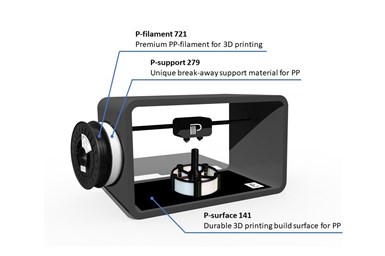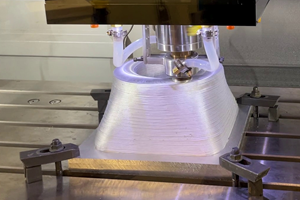New Materials Support Medical-Grade Polypropylene Extrusion
PPprint’s latest portfolio of polypropylene grades support extrusion AM use for custom medical parts, like orthotics and orthopedic aids.

Polypropylene grades from PPprint meet the stringent material requirements for use in additively manufactured custom orthoses and orthopedic aids. Photo Credit: PPprint
While additive manufacturing’s elimination of retooling makes it attractive to assistive aid manufacturers customizing and personalizing products for individual patients, proper materials must achieve compatibility with additive manufacturing methods at high qualities before any manufacturing takes place. These materials must satisfy several chemical, biological and technical standards, with certain applications also requiring satisfaction of break resistance and flexibility standards. Other applications might call for the ability to easily clean or sterilize the material, or for suitability for skin contact.
The affordability and quality of 3D extrusion printers has made extrusion-based techniques like FDM and FFF dominant in the medical market, but established extrusion-based 3D printing materials like PLA and ABS don’t reach the required performance profile required for many medical applications. PPprint GmbH means to change matters with its polypropylene product portfolio.
Positive Points of Polypropylene
Polypropylene is one of the world's most-consumed plastics, and has already proven capable in many injection molding and extrusion applications across multiple industries — including medical. PPprint says recycling polypropylene is quick and efficient, making it attractive from a sustainability perspective, while its resistance to acids, bases, alcohol and water appeals to medical manufacturers. Several grades of polypropylene are skin-friendly and non-hazardous to health, and many grades are compatible with sterilization processes and can be cleaned manually or in a dishwasher.
Unfortunately, many polypropylene grades prove difficult to 3D print in terms of interlayer bonding, warpage, bed adhesion and reliable support materials. Solutions such as adhesive tapes or glues are not suitable for industrial applications, and turn many users away from using polypropylene. PPprint believes its product portfolio solves these issues and enables the reliable printing of high-quality polypropylene parts of any shape complexity and geometry.

PPprint is offering three unique grades of polypropylene for additive manufacturing: P-filament 721 for the main body, P-support 279 for supports and P-surface 141 for build plates. Photo Credit: PPprint
Solving Material Challenges
Successful extrusion-based printing of polypropylene requires a printed material with a low warpage and high interlayer bonding strength, a support material for overhangs and openings that can be easily removed from the finished part, and a 3D printing build surface that allows both reliable 3D printing of polypropylene parts and the non-destructive and residual-free removal of the finished part without any additional chemicals.
Building on its founders’ research experience with polyolefins, PPprint developed polypropylenes to solve these three challenges. The main product of PPprint’s portfolio is “P-filament 721,” which is available in the diameters of 1.75 mm and 2.85 mm. The filaments offer low warpage and very high interlayer bonding strength, with the “P-filament 721 natural” grade meeting DIN EN ISO 10993-5 biological safety certification requirements, which govern medical devices in contact with skin.
Next, PPprint developed its “P-surface 141” 3D printing build surface, which supports reliable and reproducible printing of polypropylene with simple, defect-free removal of 3D printed parts at elevated temperatures.
The third pillar of PPprint’s polypropylene catalog is “P-support 279,” a break-away support filament which enables the production of detailed and complex structures containing bridges, overhangs, and openings. This support material adheres very well to polypropylene printed parts as well as to “P-surface 141,” and can be easily and cleanly removed at elevated temperatures.
Polypropylene for Adaptive Aids
Adaptive aids such as orthoses or orthopedic aids enable individuals with physical injuries, mobility limitations or disabilities to live as independently as possible. These gadgets can increase a person's mobility, degree of function and capacity to execute daily tasks. Considering the variety of physical limitations that people may experience due to genetics, illness or injury, these devices must address an vast set of requirements while being adaptable to particular user-specific criteria. As a result, assistive aids must be highly customized to be effectively functional — making them prime candidates for additive manufacturing.

This 3D printed leg splint used P-filament 721 as the base, with P-support 279 as the break-away support material. The support is recyclable, promoting sustainability. Photo Credit: PPprint
One practical example of these polypropylene grades coming together is a 3D printed leg splint made from P-filament 721 and support material P-support 279. The support material provided high stiffness and low warpage while maintaining adherence to the printed polypropylene part and P-surface 141. The user could also print rafts and support structures on top of the printed part, then cleanly and easily remove the support material after heating up to 210° to 230°F (100° to 110°C). The break-away support did not require solvent or create an aqueous polymer containing waste, and still proved simple enough to recycle, promoting sustainability in several ways.
In short, extrusion-based 3D printing with polypropylene grades like those from PPprint enables unique, complex geometries that support the stabilization, immobilization, relief, guidance, or correction of different body parts and boost the healing process. With these geometries and materials, medical manufacturers can produce customized orthoses or orthopedic aids that are comfortable and effectively withstand mechanical stresses.
Related Content
NematX Develops NEX 01 High-Precision Material Extrusion Platform
Formnext 2022: NematX developed the NEX 01 material extrusion platform to optimally process its liquid crystal poylmers (LCP) for 3D printing to unlock their full potential.
Read MoreUnusual Forms of 3D Printing, and How to Categorize This Technology: AM Radio #21A
In this episode of AM Radio, Stephanie Hendrixson and Peter Zelinski quiz each other on six 3D printing processes — some common, some novel. Test your own knowledge and stick around for a discussion about how to categorize (or maybe re-categorize) AM technologies.
Read MoreMarkforged Reformulates H13, D2 Tool Steel for More Flexible, Less Brittle Filaments
The new filaments are reformulations of Markforged’s most popular tool steels.
Read MoreChromatic RX-Flow 3D Printers for Reactive Extrusion Additive
RX-Flow printers are a low-cost option for manufacturers interested in testing and implementing industrial 3D printing with more durable, flexible materials than are available with FDM, SLA and other 3D printing technologies.
Read MoreRead Next
Video: Intelligent Layering Metal 3D Printing at 3DEO
Contract manufacturer 3DEO delivers metal parts using Intelligent Layering, a binder jetting-like 3D printing process the company developed and operates internally. Here’s how it works.
Read MoreLooking to Secure the Supply Chain for Castings? Don't Overlook 3D Printed Sand Cores and Molds
Concerns about casting lead times and costs have many OEMs looking to 3D print parts directly in metal. But don’t overlook the advantages of 3D printed sand cores and molds applied for conventional metal casting, says Humtown leader.
Read MoreTo Improve Performance of Compression Molded Composites, Add 3D Printed Preforms
9T Labs' Additive Fusion Technology enables the manufacture of composite structures with as much or as little reinforcement as is necessary, using 3D printed continuous fiber preforms to add strength just where needed.
Read More








.png;maxWidth=300;quality=90)














